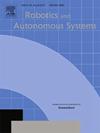高山机器人:在山地环境中作业的攀爬机器人
IF 4.3
2区 计算机科学
Q1 AUTOMATION & CONTROL SYSTEMS
引用次数: 0
摘要
山坡是恶劣环境的完美例子,在这种环境中,人类需要执行困难和危险的操作,例如移除不稳定的巨石,危险的植被或部署安全网。攀爬机器人可以很好地替代人类的干预。文献中存在的不同解决方案由于需求的难度(导航、重载荷、任务执行的灵活性)而无法满足任务。在本文中,我们提出了一个机器人平台,可以填补这一空白。我们的解决方案是基于一个挂在绳子上的机器人,它用一条可伸缩的腿从山壁上跳下来。我们的机械解决方案包,以及为运动规划和控制开发的算法,在不规则和陡峭的斜坡上提供快速导航,克服或绕过重大自然障碍的可能性,以及携带重型有效载荷和执行复杂任务的能力。在本文中,我们充分介绍了我们的主要设计和算法选择,并通过大量的物理模拟场景展示了解决方案的可行性。本文章由计算机程序翻译,如有差异,请以英文原文为准。
ALPINE: A climbing robot for operations in mountain environments
Mountain slopes are perfect examples of harsh environments in which humans are required to perform difficult and dangerous operations such as removing unstable boulders, dangerous vegetation or deploying safety nets. A good replacement for human intervention can be offered by climbing robots. The different solutions existing in the literature are not up to the task for the difficulty of the requirements (navigation, heavy payloads, flexibility in the execution of the tasks). In this paper, we propose a robotic platform that can fill this gap. Our solution is based on a robot that hangs on ropes, and uses a retractable leg to jump away from the mountain walls. Our package of mechanical solutions, along with the algorithms developed for motion planning and control, delivers swift navigation on irregular and steep slopes, the possibility to overcome or travel around significant natural barriers, and the ability to carry heavy payloads and execute complex tasks. In the paper, we give a full account of our main design and algorithmic choices and show the feasibility of the solution through a large number of physically simulated scenarios.
求助全文
通过发布文献求助,成功后即可免费获取论文全文。
去求助
来源期刊

Robotics and Autonomous Systems
工程技术-机器人学
CiteScore
9.00
自引率
7.00%
发文量
164
审稿时长
4.5 months
期刊介绍:
Robotics and Autonomous Systems will carry articles describing fundamental developments in the field of robotics, with special emphasis on autonomous systems. An important goal of this journal is to extend the state of the art in both symbolic and sensory based robot control and learning in the context of autonomous systems.
Robotics and Autonomous Systems will carry articles on the theoretical, computational and experimental aspects of autonomous systems, or modules of such systems.
 求助内容:
求助内容: 应助结果提醒方式:
应助结果提醒方式:


